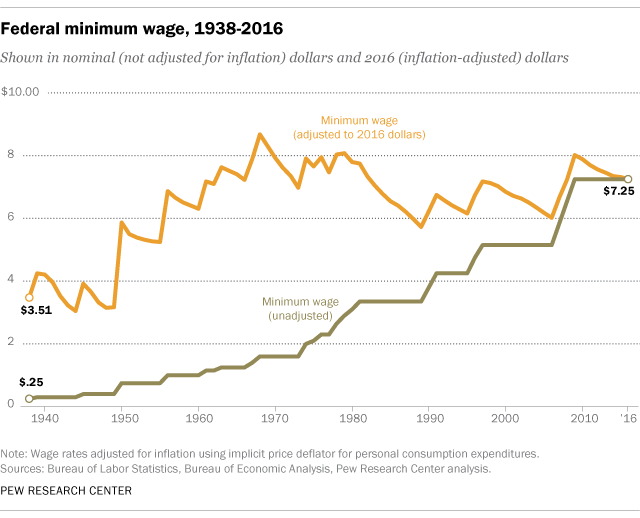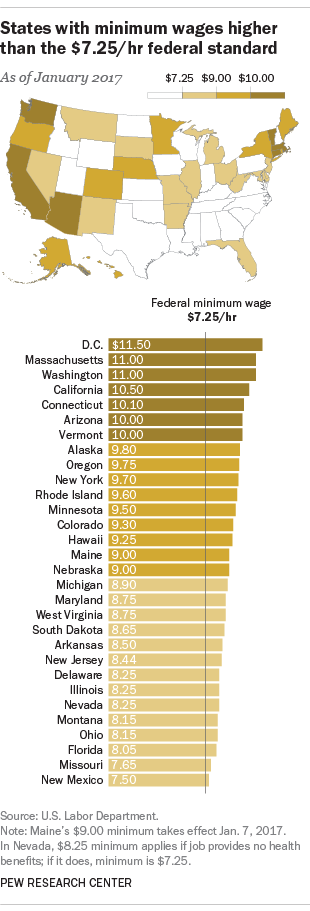
Even though the federal minimum wage has remained at $7.25 an hour since 2009, most Americans are now covered by higher minimums set by state and local laws – from Los Angeles to New York state to Washington, D.C. Organized labor and anti-poverty groups continue to push for $15 an hour as the new standard for all workers paid hourly, though given Republican control of Congress that prospect appears dim.

While the idea of raising the minimum wage is broadly popular, a Pew Research Center survey this past August found clear partisan and racial differences in support. Overall, 52% of people favored increasing the federal minimum to $15 an hour, but that idea was favored by just 21% of Trump supporters (versus 82% of Clinton backers). And while large majorities of blacks and Hispanics supported a $15 federal minimum wage, 54% of whites opposed it,
Here are five facts about the minimum wage and the people who earn it:
Adjusted for inflation, the federal minimum wage peaked in 1968 at $8.68 (in 2016 dollars). Since it was last raised in 2009, to the current $7.25 per hour, the federal minimum has lost about 9.6% of its purchasing power to inflation. Back in 2015, The Economist estimated that, given how rich the U.S. is and the pattern among other advanced economies in the Organization for Economic Cooperation and Development, “one would expect America … to pay a minimum wage around $12 an hour.”
Less than half (45%) of the 2.6 million hourly workers who were at or below the federal minimum in 2015 were ages 16 to 24. An additional 23.3% are ages 25 to 34, according to the Bureau of Labor Statistics; both shares have stayed more or less constant over the past decade. That 2.6 million represents less than 2% of all wage and salary workers. (See more about the demographics of minimum-wage workers.)

Twenty-nine states, plus the District of Columbia and nearly two dozen cities and counties, have set their own higher minimums. State hourly minimums range from $7.50 in New Mexico to $11.50 in D.C., according to the U.S. Department of Labor’s Wage and Hour Division. Together, these states include about 61% of the nation’s working-age (16 and over) population, according to our analysis of U.S. Census Bureau data. Among the cities that have enacted even higher local minimums are San Francisco ($15 by 2018), Seattle ($15 by 2021), Chicago ($13 by 2019) and San Diego ($11.50 by 2017), according to the National Employment Law Project. And in 12 states, the minimum wage rises automatically each year based on a cost-of-living formula.
About 20.6 million people (or 30% of all hourly, non-self-employed workers 18 and older) are “near-minimum-wage” workers. We analyzed public-use microdata from the Current Population Survey (the same monthly survey that underpins the BLS’s wage and employment reports), and came up with that estimate of the total number of “near-minimum” U.S. workers – those who make more than the minimum wage in their state but less than $10.10 an hour, and therefore also would benefit if the federal minimum is raised to that amount. The near-minimum-wage workers are young (just under half are 30 or younger), mostly white (76%), and more likely to be female (54%) than male (46%). A majority (56%) have no more than a high-school education.

The restaurant/food service industry is the single biggest employer of near-minimum-wage workers. Our analysis also found that 3.75 million people making near-minimum wages (about 18% of the total) worked in that industry. Among near-minimum workers aged 30 and younger, about 2.5 million (or nearly a quarter of all near-minimum workers in that age bracket) work in restaurants or other food-service industries. But because many of those workers presumably are tipped, their actual gross pay may be above $10.10 an hour. (Federal law, as well as wage laws in many states, allows tipped employees to be paid less as long as “tip credits” bring their pay up to at least the applicable minimum.)
Correction: A previous version of the state minimum wage graphic reversed the colors of two states in the map only (the list was correct).
Note: This is an update of a post originally published in December 2013 and previously updated in July 2015.
Related posts:
